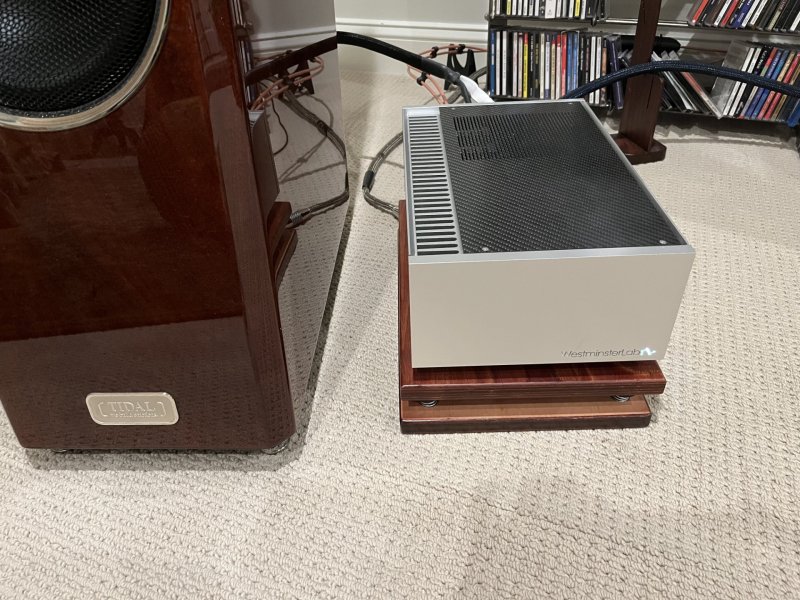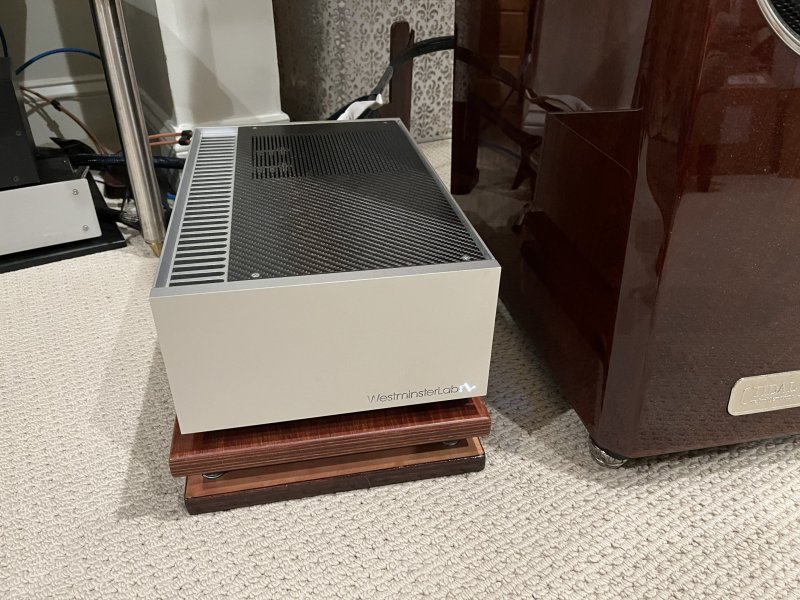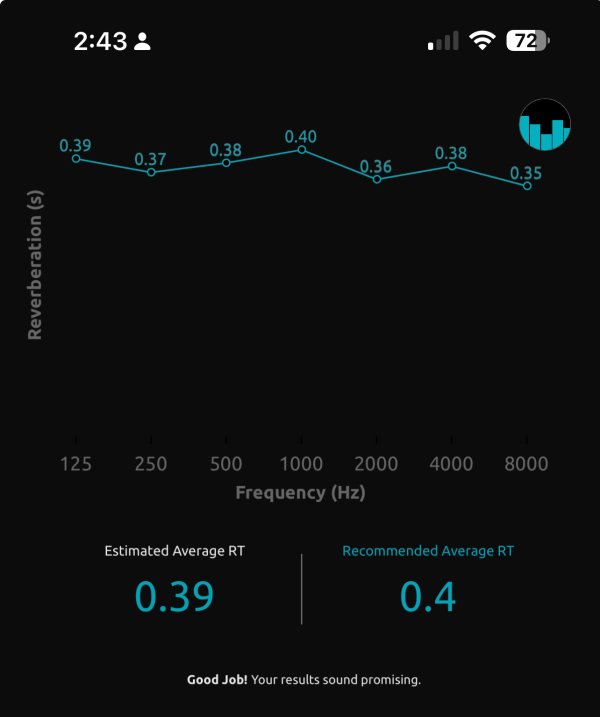I apologize for my lengthy response below and regrettably it’s also incomplete. But when talking about vibration mgmt. we’re talking about the greatest performance bottleneck in all high-end audio. IME, nothing else comes remotely close.
First, I am unwilling to make a video of my system playing music with my iPhone. I see that as just silly. If you want to hear my system in person, I am agreeable to that. An iPhone video will show that yes, it makes music but that's all it can do.
Understood. In-room videos obviously do not capture the entire gestalt of the in-room experience so likewise on its face, videos can logically seem silly. But that doesn’t mean in-room videos via smartphone are silly to everybody. So even though you may think an in-room video is silly, must that prevent you from sharing an in-room video for others who may find some value?
Your questions are thought provoking and challenging, so I will do my best to answer.
1) Floor borne vibrations are the biggest problem. Isolation of the speakers and then the amps, preamps, DAC, etc all provided dramatic improvements in the sound.
The term isolation probably ought to be a bit better defined because though simple sounding on paper (on its face), as we can see isolation in high-end audio covers numerous as opposed to singular potential concepts including damping, absorption, weight, etc. as well as numerous as opposed to singular principles, designs, materials, executions, etc.
IMO, superior forms of isolation implies a complete severing of the mechanical / electrical energy conduit. For example. I have a table lamp and one sure-fire way to ensure no energy ever gets to the lightbulb is to take a pair of scissors and severe the lamp cord. Instant isolation. No waiting for further improvements down the road because in a moment in time that lightbulb is instantaneously 100% isolated from electric current.
Would you agree that this is a good-enough analogy of a genuine act of isolation from an energy source?
2)Clarity, imaging, well defined bass, deep bass that goes through the floor are the improvements that I found very apparent with spring isolation. I isolated my previous speakers with spring platforms and was amazed at the improvement in clarity and bass. Then later I tried the Isoacoustic Gaias on my speakers. While they do not isolate perfectly like springs, they improved the sound even more. I use those spring isolation platforms now on my subwoofers in my HT system. The bass is very deep and clear now in my HT system. I highly recommend that tweak. And that leads to your next question.
Good examples but I’ll address at another time.
3) I believe that the bulk of internally generated vibrations in components- except for speakers, turntables and CD drives come from the power transformers. That's only my semi-educated guess. Therefore, components need rubber dampers and spikes/cones to drain that energy away.
One problem right off the bat is that rubber in and of itself acts as an isolator not a damper while spikes/cones are not isolators but are energy conduits allowing energy to travel. One object potentially impedes or traps energy's ability to travel while the other potentially expedites the transfer of energy away from its point source.
Two important notes:
1. To the best of my knowledge, all energy seek first and foremost to travel away from its point source.
2. Just because a mfg’er calls their rubber products dampers or calls their spikes/cones isolators does not necessarily make it so. In fact, it’s usually just an indicator that they too are caught up in common misunderstandings (preconceived narratives?). Often times one must analyze the design, materials, executions, etc. to determine which camp a product genuinely belongs. IOW, we must stop assuming everybody knows what they’re talking about – IME, more so with vibration mgmt. than any other sector.
Anyway, so already we’re polluting the isolation methodology with the energy transfer methodology and vice versa, right? IOW, we’re now mixing two opposing methodologies. Isn’t this like trying to mix light with dark, on with off, hot with cold, etc?
Doesn’t the isolation methodology in its purest form work best all by its lonesome? Likewise, doesn’t the energy transfer methodology in its purest form also work best all by its lonesome? Don’t both of these methodologies each belong in their own basic laws of nature/physics camp? Are not these two methodologies polar opposites of each other?
If the answer is yes, then what in the world are we doing trying to create some sort of hybrid of both as our final/best solution?
I learned for myself first hand with my speakers and recently with my preamps and amps. I think the Gaia feet on the speakers provide some amount of damping/energy drain along with isolation. They have them tuned or balanced between both for optimum sound. Too much damping colors the sound while complete isolation has no downside with some exception when energy cannot drain. I found putting the front of my preamps on cones and leaving the back of the preamps on their rubber feet provides a good balance of energy drain and damping. The preamp sounds faster when not resting on all four rubber feet. However, don't forget that the base the preamp is sitting on is perfectly isolated. I also found the type of material for that base makes a difference in the sound. I tried Delrin, bamboo and Acia wood. Of the three, I like the Acacia wood for the preamps.
Fair enough. Based on what you describe above, when one mixes (think pollutes) two otherwise pure methodologies, what kind of results ought one genuinely expect? Here’s a few more questions for you…
1. If in our endeavors we realize a genuine sonic improvement, does that automatically imply we are on a superior path and methodology?
2. Is it possible for those on an inferior path to also realize sonic improvements?
3. What is the best and perhaps only way those on an inferior path when embracing inferior methodologies can realize genuine sonic improvements?
4. From an isolation purist perspective what does an object become when sufficiently damped?
5. From an energy transfer purist perspective what does an object become when sufficiently damped?
6. From an intermixed methodologies hybrid perspective what does an object become when sufficiently damped?
I’m not an engineer but I am a fundamentalist. So in my case I choose what I think is the superior methodology and if performance was absolutely paramount to me (it is), then I do my reasonable best to ensure I never cross methodology streams. Only then might I stand a chance to achieve maximum benefit that methodology has to offer, right?
Hopefully it becomes a bit more apparent when we intermix two primary methodologies, not only have we cut the potential performance legs out from underneath both methodologies, we’ve also just created a bottomless hybrid rabbit hole. IOW, much like a box of chocolates, we’ve zero clue what the hybrid’s results may be.
And that’s not even yet taking into account our ability to somehow apply only superior forms of managing the intermixing of two polar opposite methodologies aka interoperability skills.
I had a longer response here but to keep it shorter I’ll just say… Like everybody else, it seems you’re doing your reasonable best to keep ALL unwanted resonant energy captured at the component to remain trapped within the component, regardless of its source.
The BIG question is why? Are you aware that once unwanted resonant energy is captured at the component, regardless how it got there, then doesn’t the component (and its internals) become the new point source for this unwanted resonant energy?
Back to floor- and air-borne vibrations. No matter what we do, will at least some unwanted floor- and air-borne vibrations still reach the components? According to your steel ball exercise the answer is obviously yes.
What is the natural behavior of energy again? To travel away from its point source.
What is the natural behavior of energy when its ability to travel is impeded?
4) Room acoustics are just as critical as vibrations. The room has to have balance. Too much damping and the music sounds lifeless. Too little damping and the music is muddied and blurred. In addition, highs can sound harsh and sibilance out of control. I worked for several months on my room acoustics. I have corner bass traps, absorbers on the front wall behind the speakers and diffusers on the ceiling. I worked several days with the diffusers placing them in various locations- same for the absorbers. Interestingly, I was at Hifi Buys in Atlanta last summer where I traded in my 5SE for the 6SE preamp. I was listening to their top system in their best room. I remarked about the amount of reverb in the room. The sales person told me of an app for my phone called Impulso. It requires you to place your phone at your listening position and then pop a balloon at the speaker position. The app analyzes the room to see if the decay is too fast or too slow. I'm proud to say that my room measured almost perfect. I managed to do that by ear. I'll be the first to say I was more lucky than good.
See plot of my room decay measurement below. Always good to find ways to calm my audio neurosis.
We’re straying off topic with this section so no comment.
BTW, I have a punch line that should help clear some/all of this mess up but I've a few more notes to share and hopefully some of this here is thought provoking.





